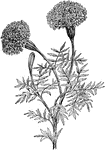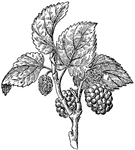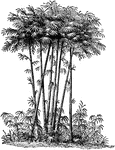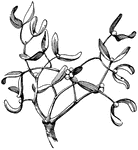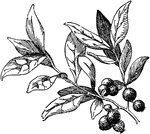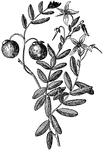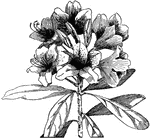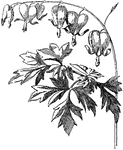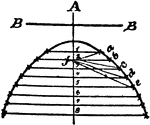
Construction Of A Parabola
An illustration showing how to construct a parabola by plotting. "Having given the axis, vertex, and…
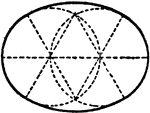
Construction Of An Ellipse
An illustration showing how to construct an ellipse using circle arcs. "Divide the long axis into three…
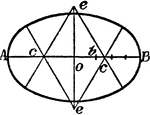
Construction Of An Ellipse
An illustration showing how to construct an ellipse using circle arcs. "Given the two axes, set off…
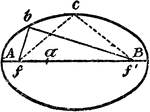
Construction Of An Ellipse
An illustration showing how to construct an ellipse. Given the two axes, set off half the long axis…

Construction Of A Cycloid
An illustration showing how to construct a cycloid. "The circumference C=3.14D. Divide the rolling circle…
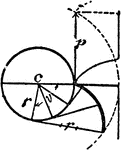
Construction Of An Evolute Of A Circle
An illustration showing how to construct an evolute of a circle. "Given the pitch p, the angle v, and…

Construction Of A Parabola
An illustration showing how to construct a parabola. "Given the vertex A, axis x, and a point P. Draw…
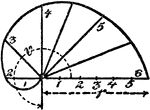
Construction Of An Arithmetic Spiral
An illustration showing how to construct an arithmetic spiral. "Given the pitch p and angle v, divide…
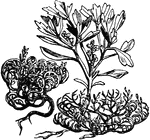
Illustration of Roots and Jericho Rose
A small cruciferous plant, growing in arid Arabia and Palestine. When full grown and ripe its leaves…
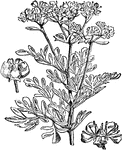
Rue Plant
A strong-scented herbaceous plant of the genus Ruta, nat. order Rutacae, a native of S. Europe, but…
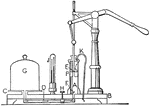
Air Pump
"A pump for exhausting air and other gases from a closed space, or for compressing air within an enclosed…

Saw Fly Hovering Above a Plant
A group of insects belonging to the order Hymenoptera, and distinguished by the peculiar confirmation…
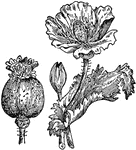
Opium Plant
The opium plant can be used to produce sleep, numb pain, and quiet the organs of the body.

The Right Lung of a Goose
In birds the lungs are confined to the back wall of the chest. They are not separated into lobes, but…
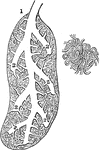
Section of the Lung of a Bird
In birds the lungs are confined to the back wall of the chest. They are not separated into lobes, but…

The Heart and Arteries of a Lobster
In the class of Crustacea there is a single ventricle, which receives the blood from the gills and propels…

Longitudinal Section of a Kidney
A longitudinal section of a kidney. Labels: 1, 2, 3, Parts of the Kidney. 4, Pelvis. 5, Ureter. 6, Renal…
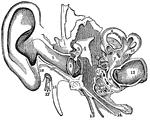
Parts of the Ear
A view of all the parts of the ear, Labels: 1, The tube that leads to the internal ear. 2, The membrana…

Intrusion Machine
"The principal working parts of the apparatus are the sheet of boiler plate a (fig. 100), the cylinder…
Flower Parts
"Diagram to show the essential parts of a "flowering" plant. t.r., tap-root; cot. seed-leaf (cotyledon);…
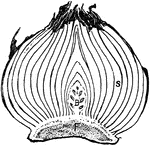
Tulip Bulb
"Tulip bulb; longitudinal section. F, solid stem; B, flower bud; S, leaf-bases serving as bud-scales,…

Sedum Leaf
"Leaf of a live-forever (Sedum sp.), with a portion of the epidermis peeled back. Underneath the epidermis…

Mullein Leaf
"Mullein (Verbascum Thapsus). L, cross-section of leaf-blade, showing relative thickness of a layer…

Leaf Epidermis
"Lizard's tail (Saururus cernuus). Portions of leaf-epidermis; U, upper epidermis; L, lower epidermis;…
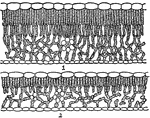
Oak Leaf Cross-Section
"Cross-sections of leaves of an oak (Quercus novimexicana), showing the effect of different light conditions…
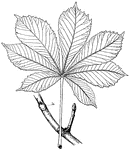
Horse-Chestnut Leaf
"Horse-chestnut (Aesculus Hippocastanum). ls, leaf-scar, showing scars of seven fibro-vascular bundles,…

Water Hyacinth Roots
"Roots of the water-hyacinth (Eichornia crassipes Solms), showing removable root-caps; b, root-cap removed…
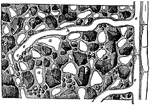
Roots in Soil
"Diagram to illustrate a root-hair (h) in the soil, and its relation to the soil-particles, the capillary…

Castor-Oil Plant Stem
"Diagram showing tissue-systems in young stem of castor-oil plant (Ricinus communis), as seen in cross-section.…
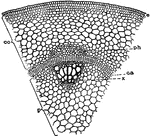
Castor-Oil Plant Stem
"The castor-oil plant (Ricinus communis). Portion of cross-section of young stem. co, Cortex; p, pith…
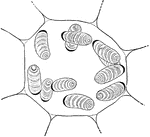
Pellionia Plant Cell
"Cell of Pellionia Daveauana, showing starch-grains. The black, crescent-shaped body on the end of each…
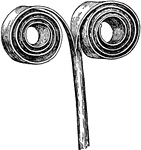
Dandelion Scape
"Portion of dandelion scape, showing "curls" resulting from longitudinal tissue-tension." -Gager, 1916

Knight's Experiment
"Knight's experiment, substituting centrifugal "force" for gravity" proved that stems do not grow upwards…
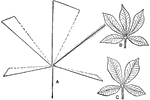
Leaflet Removal
"Effect of removal of a leaflet from a palmately compound leaf (e.g. Woodbine). B, normal leaf; C, after…
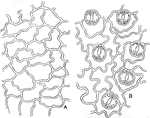
Fern Epidermis
"A, Upper epidermis; B, lower epidermis, of the fern, Drynaria meyeniana." -Gager, 1916

Fern Germination
"Germination of the spores of a fern. a, Before germination; b, early stage, showing protonema (pr.),…
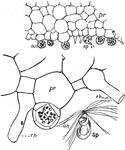
Fern Prothallus
"Fern prothallus; cross-sections showing antheridia (an), sperms (sp), and rhizoids (rh). Below at the…
Southern Adderstongue
"Adder's tongue fern (Ophioglossum vulgatum L.). R, runner or stolon." -Gager, 1916

Vegetable Cell
A, A young vegetable cell, showing cell cavity entirely filled with granular protoplasm enclosing a…
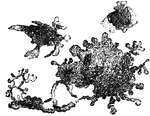
Connective Tissue Cells from a Frog
Flat, pigmented, branched connective tissue cells from the sheath of a large blood vessel of a frog's…
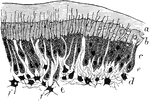
Deposition of Dentine
Part of section of developing tooth of a young rat, showing the mode of deposition of the dentine. Labels:…

Torn Muscular Fiber
Muscular fiber torn across; the sarcolemma still connecting the two parts of the fiber.

Sarcostyles from Wasp
Sarcostyles from the wing muscle of a wasp. A, A'. A sarcostyles showing degrees of retraction. B. A…
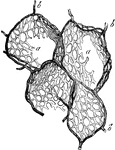
Capillary Vessels of Air Cells
The form of the capillary network presents considerable variety in the different textures of the body:…
